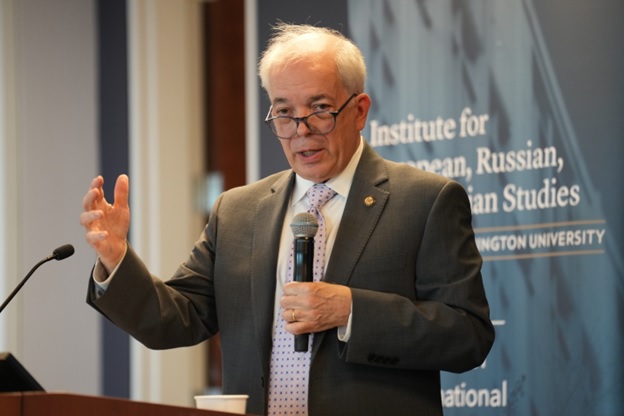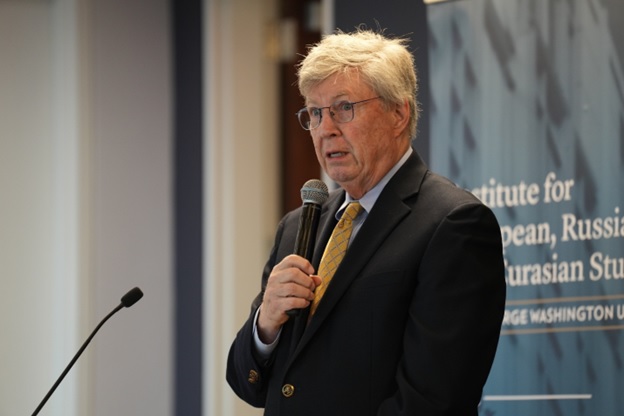

Eric Rudenshiold

Ambassador William Courtney
Central Asia’s Rise Discussed at GW’s Elliott School of International Affairs
By Elaine Pasquini
Photos by Phil Pasquini
Washington: The Central Asia Program at George Washington University’s Elliott School of International Affairs hosted a well-attended program on April 29, 2025, about the geopolitical shifts in Central Asia and the region’s quest for autonomy and sustainability.
Ambassador William Courtney, former ambassador to Kazakhstan and Georgia, shared his reflections on the United States relationship with post-Soviet Central Asia going back to 1991 when all five republics declared sovereignty.
Arriving in Almaty in 1992, Courtney related he saw the “determination and spirit of Kazakhstanis as they battled hardship, sought opportunities and forged a path ahead.”
The US “gave early and strong support to the sovereignty, independence and territorial integrity of the new states,” he said. “And within weeks of independence, Secretary of State James Baker flew to all five of the new countries in Central Asia. American began a large aid program. The Voice of America and Radio Liberty increased programing.”
Central Asians were receptive to US interests, he said. “They saw it as boosting their international legitimacy, strengthening their leverage with neighbors and bringing economic benefits.”
Presently, however, the US is slashing foreign assistance and educational and cultural programs, which will diminish US influence on Central Asia.
Stressing that today Central Asia is a major player in the areas of critical rare earths, oil and natural gas, Courtney enumerated the following statistics:
- Kazakhstan is the world leader in uranium production and ninth in copper production.
- Turkmenistan is the fifth-largest country with proven natural gas reserves.
- Uzbekistan is the fifth-largest producer of uranium and the ninth of gold globally.
- Tajikistan ranks 29th in hydro-electric generation. When the Rogun Dam is finished Tajikistan will climb even higher.
- Kyrgyzstan ranks 44th in hydro-electric generation.
“All of these factors are of interest to US investors,” he said.
In energy, Kazakhstan is in a class by itself, Courtney continued. The Tengiz oil field, a joint venture of Chevron and Exxon, has become the world’s deepest producing supergiant oil field. This venture has paid over $200 billion to Kazakhstani employees, suppliers, shareholders and the state. It is the largest foreign joint venture in a former Soviet state.
US companies are also investing in the huge Kashagan deposits. Kazakhstan oil, exported through southern Russia via the Caspian Pipeline Consortium to the West, is exempt from US sanctions, he said.
Eric Rudenshiold, senior fellow for Caspian affairs at the Caspian Policy Center and previous National Security Council Director for Central Asia under Presidents Trump and Biden, noted that Central Asia is often defined as a victim of great power competition, pulled in different directions by China, Russia and the West.
Rudenshiold, however, argued that is an “outdated understanding of what has happened in this recently evolving region.”
The advent of the Trans-Caspian Middle Corridor has reconnected Central Asia and the Caucasus and highlighted the importance of this consequential trade network, he pointed out.
Russia’s 2022 full-scale invasion of Ukraine disrupted trade between the Central Asians and their traditional partners. It also upended their banking systems and highlighted the region’s economic dependence on Russia.
The war in Ukraine and subsequent sanctions have shown Europe and the Trans-Caspian region the urgent need to diversify supply chains to avoid secondary sanctions and to develop new reliable route options, he said. The Middle Corridor offers an alternative route, combining a flexible network of rail, sea and road transport systems which provides flexibility for markets in Central Asia, the Caucasus and Europe to move cargo rapidly.
Now, numerous European bilaterial commitments are focusing on the Trans-Caspian trade route and investing in it at levels far beyond what Russia was able to do.
For example, Bulgaria recently announced a massive $1.8 billion bilateral investment in the Middle Corridor’s railway network which will connect the Baku-Tbilisi rail line to Serbia via Bulgaria through a modern, high-speed rail system that will expand the Middle Corridor into the part of Europe connecting directly to the Trans-European Transport Network, the TEN-T.
Tying into Europe’s own multimodal transport network, it has the prospect of sustainably linking Central Asia and the Caucasus to transport flows of people and goods across Europe and into Asia. Ursula von der Leyen, president of the European Commission, in a recent summit described the Middle Corridor as the very definition of a “global gateway in the heart of Eurasia.”
The Middle Corridor connects China’s Belt and Road Initiative [BRI] to Europe’s transit route. “Merging these two growth initiatives, the Middle Corridor has not only found its legs, it has learned to walk and it is actually now even starting to run.” Rudenshiold enthused.
The strategic location of the Middle Corridor offers a counterbalancing alternative that reduces dependence on Moscow and offers Europe the supply chain resilience that it did not have otherwise, he continued. And it provides Central Asia and the South Caucasus access to international markets on their own terms, not terms dictated to them by their large neighbors. This continued expansion of the trade route is a “gamechanger,” he stated.
Rudenshiold also discussed Central Asia’s abundance of critical minerals, noting that years ago these minerals were relatively inaccessible with no way to get them out. Now, there is the Middle Corridor, he pointed out. Western investment in Central Asian refineries and processing can lay the foundation for long-term partnerships that enable the countries in the region to maximize the value of their minerals as opposed to being forced to sell them at discount prices in China.
Central Asians are interested in developing, refining and processing their critical minerals, which presents many opportunities for US investment. The current US administration is looking for “partnerships with secure offtake for which I think Central Asia is made to order,” Rudenshiold said. “So, if you look at investments long-term, I think this corridor actually has a tremendous potential at this point.”
(Elaine Pasquini is a freelance journalist. Her reports appear in the Washington Report on Middle East Affairs and Nuze.Ink.)

